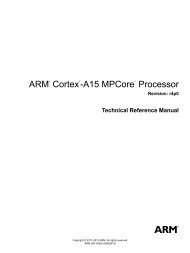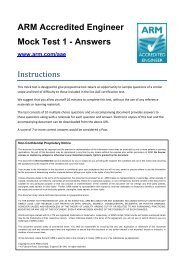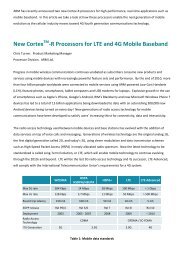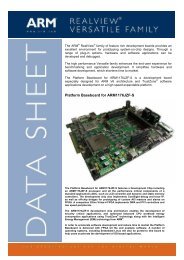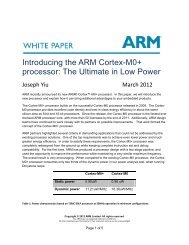32‐Bit Microcontroller Code Size Analysis - Arm
32‐Bit Microcontroller Code Size Analysis - Arm
32‐Bit Microcontroller Code Size Analysis - Arm
You also want an ePaper? Increase the reach of your titles
YUMPU automatically turns print PDFs into web optimized ePapers that Google loves.
What about moving to 16bit microcontrollers?<br />
16‐bit microcontrollers can be efficient in handling 16‐bit integers and 8‐bit data (e.g. strings)<br />
however the code size is still not as optimal as using 32‐bit processors:<br />
‐ Handling of 32‐bit data: if the application requires handling of any long integer (32‐bit) or<br />
floating point types then the efficiency of 16‐bit processors is greatly reduced because<br />
multiple instructions are required for each processing operation, as well as data transfers<br />
between the processor and the memory.<br />
‐ Register usage: When processing 32‐bit data, 16‐bit processors requires two registers to<br />
hold each 32‐bit variable. This reduces the number of variables that can be held in the<br />
register bank, hence reducing processing speed as well as increasing stack operations and<br />
memory accesses.<br />
‐ Memory addressing mode: Many 16‐bit architectures provide only basic addressing modes<br />
similar to 8‐bit architectures. As a result, the code density is poor when they are used in<br />
applications that require processing of complex data sets.<br />
‐ 64K bytes limitation: Many 16‐bit processors are limited to 64K bytes of addressable<br />
memory reducing the functionality of the application. Some 16‐bit architectures have<br />
extensions to allow more than 64K bytes of memory to be accessed, however, these<br />
extensions have an instruction code and clock cycle overhead, for example, a memory<br />
pointer would be larger than 16‐bits and might require multiple instructions and multiple<br />
registers to process it.<br />
ARM <strong>Microcontroller</strong> <strong>Code</strong> <strong>Size</strong> <strong>Analysis</strong> | Typical myths of program size 4



